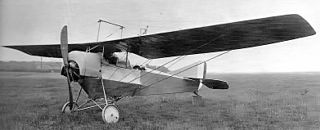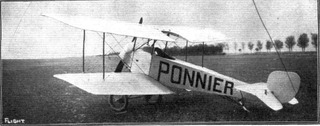Related Research Articles

The Avro Type E, Type 500, and Type 502 made up a family of early British military aircraft, regarded by Alliott Verdon Roe as his firm's first truly successful design. It was a forerunner of the Avro 504, one of the outstanding aircraft of the First World War.

The Morane-Borel monoplane was an early French single-engine, single-seat aircraft. It was flown in several European air races.

The Borel Hydro-monoplane was a French seaplane produced in 1912.

The Bristol Prier monoplane was an early British aircraft produced in a number of single- and two-seat versions.

The R.E.P. 'Parasol' Type L was a military reconnaissance aircraft designed and produced in France by Robert Esnault-Pelterie in 1914.
The Lakes Water Bird, sometimes known as the Avro Curtiss-type, is remembered as the first consistently successful British seaplane, developed by the Windermere-based Lakes Flying Company, during 1911.

The Blackburn Type D, sometimes known as the Single Seat Monoplane, was built by Robert Blackburn at Leeds in 1912. It is a single-engine mid-wing monoplane. Restored shortly after the Second World War, it remains part of the Shuttleworth Collection and is the oldest British flying aeroplane.

The Blackburn Type I was a single-engine civil two-seat monoplane built in the United Kingdom in 1913. Three were produced and used for flying demonstrations and training including seaplane pilotage.

The Handley Page Type E was a two-seat, single-engined monoplane intended as a demonstrator. Though only one was built, it flew successfully from 1912 to 1914, carrying several hundred passengers and flying several thousand miles.

The Handley Page Type F was a two-seat, single-engined monoplane designed to compete for a War Office prize for a specified military machine in 1912. It crashed before the trials got under way and, although it flew well later, only one was built.

The Dyott monoplane was a single-engined, single-seat mid-wing monoplane designed by George Miller Dyott for his own use as a sports and touring aircraft. It proved successful, making a six-month tour of the United States soon after its first flight in 1913.

The Vickers R.E.P. Type Monoplanes were a series of single-engined monoplane aircraft built by Vickers prior to the outbreak of the First World War. They were developed from a French design for which Vickers had purchased a license, with eight being built.

The ASL Viking was a single-engined two seater biplane aircraft designed and built by Horatio Barber's Aeronautical Syndicate Ltd. at Hendon. It was first flown in January 1912.

The Blériot XIII was an experimental passenger-carrying aircraft built during 1910 by Recherches Aéronautique Louis Blériot. It is notable for setting a record for passenger carrying flights, and was probably intended as a developmental aircraft for the Blériot XXIV Limousine.

The Gabardini monoplane was a successful early monoplane constructed in Italy which made several notable flights, often carrying passengers, just before World War I. During the war, a number of lower-powered Gabardini monoplanes served as a training aircraft for the military.

The Ponnier L.1 was an early French biplane single seat scout, built just before World War I. It did not reach production.

The Ponnier D.III was a French monoplane racing aircraft, designed to compete in the 1913 Gordon Bennett Trophy race. It finished a close second.

The Hanriot D.I was a French monoplane racing aircraft, designed in France in 1912 and strongly influenced by Nieuport practice. Examples were built and raced both in France and the UK during 1912.

The Blériot XXI was an early French aircraft built by Blériot Aéronautique.

The Caudron Types M and N were small, fast French sports monoplanes, flown 1911–13 under a wide range of engine powers. There was also a military version.